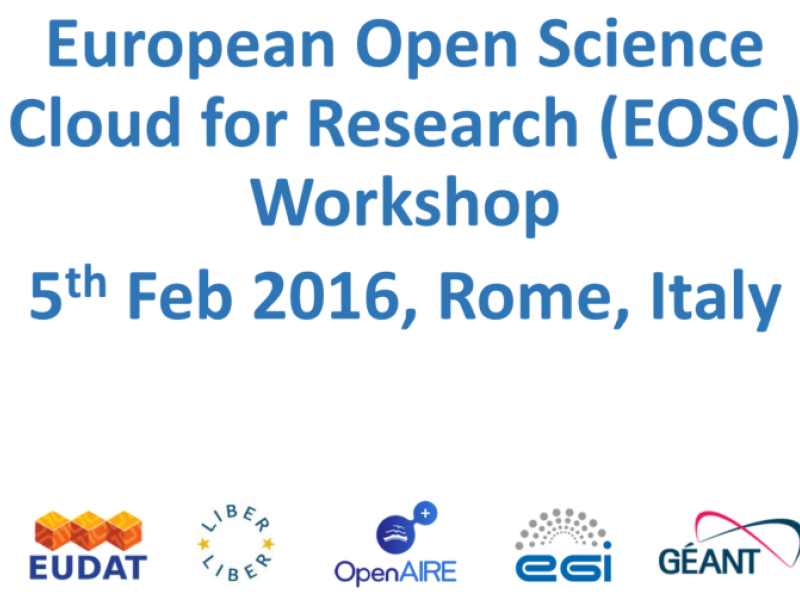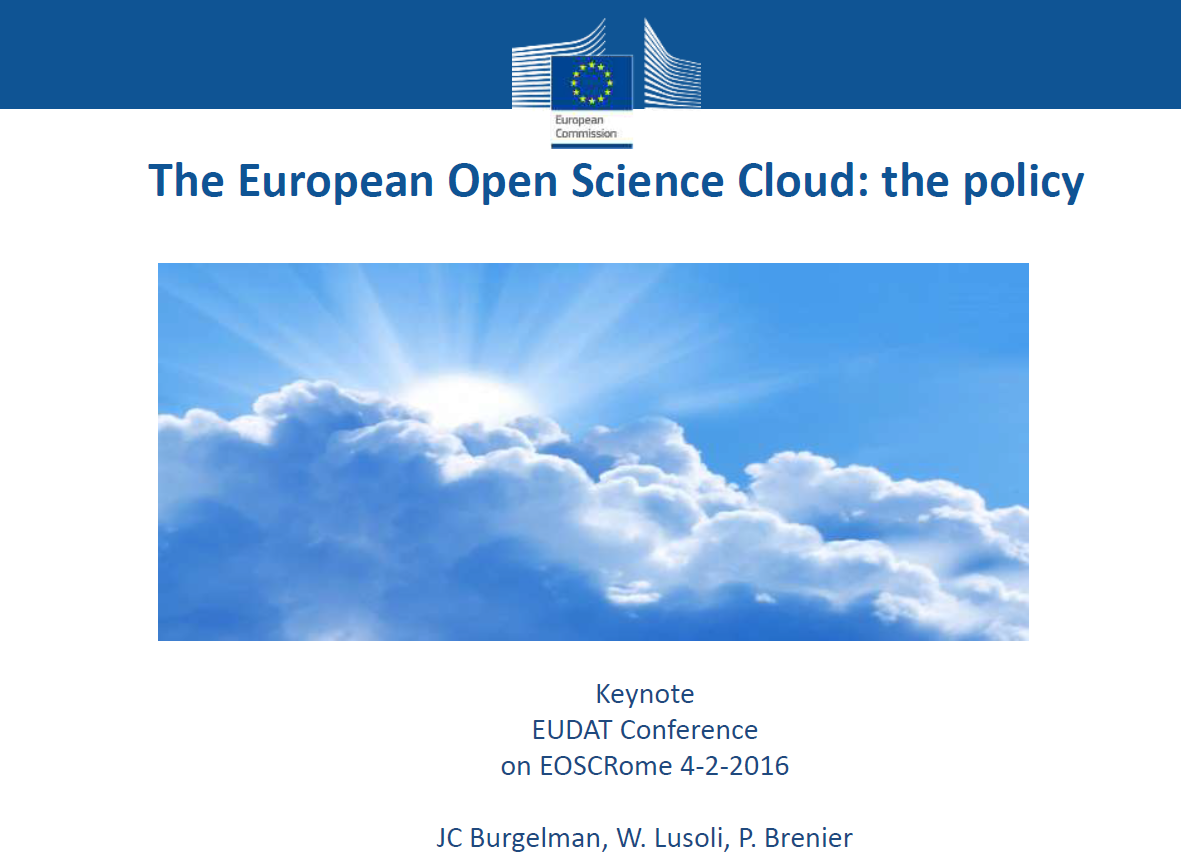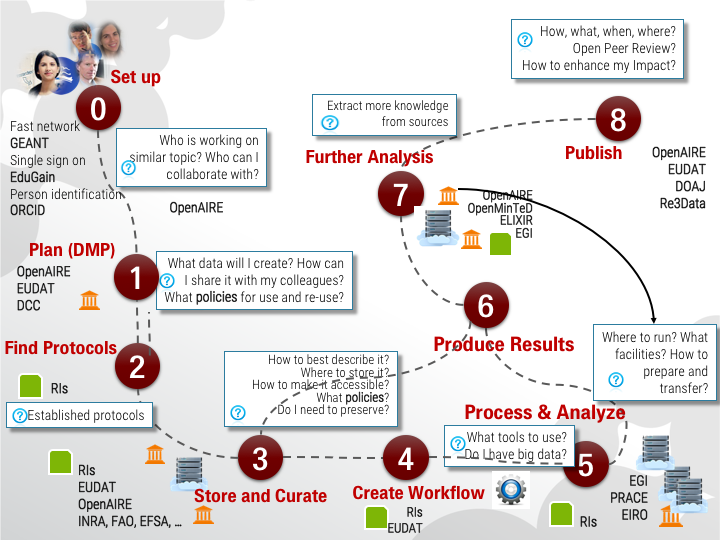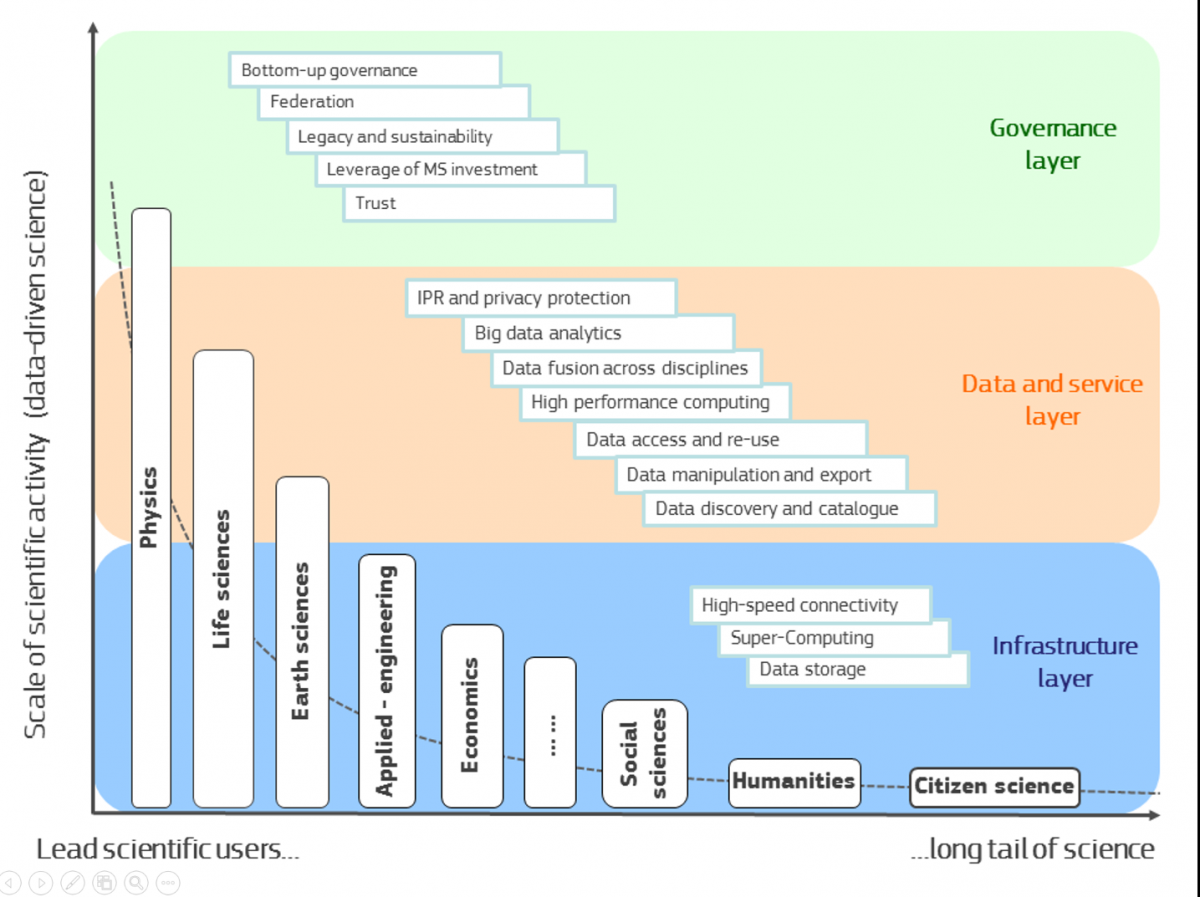
Why do we need a European Open Science Cloud for Research? The creation of a trusted environment for hosting and processing research data to support EU science in its global leading role will help overcome many key challenges currently facing scientific disciplines.
These challenges include a huge lack of awareness of the value of data and the incentives for data sharing, a continued lack of and urgent need for common standards to ensure interoperability of data. It is clear that despite recent advancements there is still not enough hardware capacity for scientific computing, storage, connectivity. The Cabinet of Commissioner Günther Oettinger recently emphasized the urgency around European Supercomputing capacity as a means for processing and exploiting the growing volumes of data, and the financial resources that are necessary to implement the HPC strategy, including paying for the infrastructure required. A further major challenge is the fragmentation and lack of coordination over different scientific communities and countries, not just between member states but even nationally and regionally. Last, but certainly not least, the recent changes in data protection and copyright rules need to be translated into the research data domain.
So how can we overcome these barriers and provide solutions to multiple and complex challenges? The European Open Science Cloud (EOSC) for Research will offer the 1.7 million European researchers and 70 million professionals in science and technology a virtual environment with free at the point of use, open and seamless services for storage, management, analysis and re-use of the data that are linked to their research activities, across borders and scientific disciplines.
 Over 120 European stakeholders gathered in Rome on 5th February to discuss the potential governance models of this initiative. Participants included all kinds of vested parties, from service providers, data centre managers, government representatives and policy makers to research community and infrastructure representatives. Each and every one central to the discussion which focused on the policy and governance aspects.
Over 120 European stakeholders gathered in Rome on 5th February to discuss the potential governance models of this initiative. Participants included all kinds of vested parties, from service providers, data centre managers, government representatives and policy makers to research community and infrastructure representatives. Each and every one central to the discussion which focused on the policy and governance aspects.
The European Commission will fund the EOSC in a series of funding rounds and with different mechanisms but with the first call scheduled to close at the end of June 2016, there is some urgency for the community to come to a consensus or at least a common agreement on the best framework for implementation. Interestingly, less than 5% of the audience represented actual end users of the platform. However, different research infrastructure managers attending and intervening indirectly represented them. During the panel discussion on expectations and requirements from Research Infrastructures, Massimo Cocco, INGV and EPOS Research Infrastructure, underlined the necessity of a central role for research infrastructures in EOSC, having already spent decades interacting with their immediate stakeholders and end users they are in a position to understand needs and requirements. He pleaded for an efficient stakeholder strategy that includes private sector engagement.
His pleas were echoed by Sanna Sorvari, Finnish Meteorological Institute and ENVRI+, an initiative representing Environmental and Earth System Research Infrastructures. She advocated for the preparatory phase project to be the inclusive and transparent and that all players, especially member states, should be included in the governance discussions from the outset, as the future prime supporters and funders of the EOSC. It is a well-known fact that 95% of European research is funded by member states.
Franciska de Jong, CLARIN Research Infrastructure, emphasised that end users must be taken into account and their expectations should be carefully managed. The quality of services deployed by EOSC is another essential element to be factored in. Francisca questioned whether all the stakeholders involved are really ready for this innovation?
In response, Jean-Claude Burgelman, European Commission, re-iterated, as he had underlined in his opening presentation, that there is no time to wait for perfection and the momentum is now: “if we don’t use it we lose it”. The European Commission set up a High Level Expert Group (HLEG) in 2015 to advise the EC on a strategy for the EOSC. Burgelman reminded the audience that any preparatory phase project must take into account the HLEG report as it is the beginning of a feasibility study on how the EOSC should look.
The chair of this HLEG, Barend Mons, gave insights to the findings of the group and the imminent report with recommendations focusing on three pillars: Policy, Governance and Implementation. Those focused on policy aspects are: the necessity to take immediate, affirmative action in close concertation with Member States. The discussion and thoughts on the ‘perceived need’ should now stop. The EOSC must build on existing capacity and expertise where possible, a strong message that was also echoed by many of the panellists. Finally, it is imperative to frame the EOSC as Supporting Internet based protocols & applications.
 In terms of governance the four recommendations are 1) to aim at the lightest possible, internationally effective governance; 2) provide guidance only where guidance is due; 3) to define Rules of Engagement for formal participation in the EOSC and 4) to federate the Gems across Member States. During successive discussions, participants asked that in addition to definition of the rules of engagement, there should be clear rules of conduct as well.
In terms of governance the four recommendations are 1) to aim at the lightest possible, internationally effective governance; 2) provide guidance only where guidance is due; 3) to define Rules of Engagement for formal participation in the EOSC and 4) to federate the Gems across Member States. During successive discussions, participants asked that in addition to definition of the rules of engagement, there should be clear rules of conduct as well.
Implementation, a critical set of recommendations, feature actions to turn the HLEG report into an EC approved White Paper to guide EOSC initiative, to develop, endorse and implement a Rules of Engagement scheme, to fund a concentrated effort to locate and develop Data Expertise in Europe, to install a highly innovative guided funding scheme for the preparatory phase. In addition, implementation should include making adequate data stewardship mandatory for all research proposals, installing an executive team to deal with international coherence of the EOSC and setting up an executive team to deal with the preparatory phase of the EOSC.
The panel on Supporting the whole research process in the EOSC was introduced with “A Day in the Life of a Researcher”, ultimately the end user of a seamless, easy to access EOSC platform that supports  them in every step of their daily work. In keeping with the EUDAT, LIBER, OPENAIRE, GÉANT and EGI vision statement of the EOSC, Europe can and must build on decades of public investment in scientific infrastructures—experimental facilities, networking, high-performance and high-throughput computing, cloud services, scientific software and institutional and community data repositories—by connecting national and international infrastructures and services to facilitate Researcher’s daily lives. Their recommendations were that any European Open Science Cloud for Research must be Open in design, participation and use; Publicly funded & governed with the 'commons approach'; Research-centric with an agile co-design with researchers and research communities; Comprehensive in terms of universality and inclusiveness of all disciplines; Diverse & distributed empowering network effects; Interoperable with common standards for resources and services; Service-oriented as well as protocol-centric and Social connecting diverse communities.
them in every step of their daily work. In keeping with the EUDAT, LIBER, OPENAIRE, GÉANT and EGI vision statement of the EOSC, Europe can and must build on decades of public investment in scientific infrastructures—experimental facilities, networking, high-performance and high-throughput computing, cloud services, scientific software and institutional and community data repositories—by connecting national and international infrastructures and services to facilitate Researcher’s daily lives. Their recommendations were that any European Open Science Cloud for Research must be Open in design, participation and use; Publicly funded & governed with the 'commons approach'; Research-centric with an agile co-design with researchers and research communities; Comprehensive in terms of universality and inclusiveness of all disciplines; Diverse & distributed empowering network effects; Interoperable with common standards for resources and services; Service-oriented as well as protocol-centric and Social connecting diverse communities.
Additionally, both Susan Reilly, LIBER and Alison Kennedy PRACE underlined the necessity to ensure that this platform provides support for education and training and equips researchers with skills to use it to its’ full potential. Education and adoption on the local level is key and this links to the importance of HPC as an essential component in OSC, many of the HPC facilities are also national data centres. The stakeholders must find ways to support new data centric user groups as well as deal with the skills shortage by working with users to understand tools & services.
 All panel discussions made it very evident that one size does not, and will not fit all. There are many, many requirements coming from different communities. The services deployed should be interoperable, orchestrating the platform and allowing users to pick and choose resources they need from the one stop shop. Peter Wittenburg, Max Planck Institute and Research Data Alliance, highlighted that competitiveness requires moving forward and that a serious culture change is required. Change in the way infrastructures are built at the moment, including the design of dynamic knowledge integration layers. The new challenges and new positioning in terms of the integration layer must be clear to the Research Infrastructures
All panel discussions made it very evident that one size does not, and will not fit all. There are many, many requirements coming from different communities. The services deployed should be interoperable, orchestrating the platform and allowing users to pick and choose resources they need from the one stop shop. Peter Wittenburg, Max Planck Institute and Research Data Alliance, highlighted that competitiveness requires moving forward and that a serious culture change is required. Change in the way infrastructures are built at the moment, including the design of dynamic knowledge integration layers. The new challenges and new positioning in terms of the integration layer must be clear to the Research Infrastructures
The European Open Science Cloud for Research reflects the change in the way research is conducted but funding and the long-term perspective is missing. To really implement a successful EOSC framework, we need the preparatory phase project to first look into governance, additional funding and sustainability of the EOSC. Incentives are needed for researchers to share and (re) use their data and this is closely tied to the quality of services which are key for the uptake and success of the platform. The EOSC needs intelligent openness on what can be shared and what not. The EOSC must build upon existing e- and research infrastructures, and it should be a mixed bag of infrastructure, tools and services presented as interoperable virtual environments, “a cloud of services”, for all European researchers to store, manage, process, analyse and re-use research data across geographical, social and technical borders.
#EOSC - http://ec.europa.eu/research/openscience/index.cfm?pg=open-science-cloud
The European Open Science Cloud for Research workshop was organised by EUDAT, LIBER, OPENAIRE, GÉANT & EGI on 5th February 2016 in Rome. Complete programme and presentations are available online.
Report authored by Hilary Hanahoe, Trust-IT Services & EUDAT Communications Outreach & Training Manager with contributions from Melanie Imming, LIBER.
The organisers are very grateful to the session convenors, speakers and panellists: Juan Bicarregui - STFC; Jean-Claude Burgelman - European Commission; Valentino Cavalli - GÉANT; Massimo Cocco - Istituto Nazionale di Geofisica e Vulcanologia; Bas Cordewener - Jisc; Franciska de Jong - CLARIN ERIC; Jurry de la Mar - T-Systems International GmbH; Matthew Dovey - Jisc; Tiziana Ferrari - EGI.eu; Alison Kennedy EPCC and PRACE; Kimmo Koski - CSC - IT Center for Science Ltd. and EUDAT; Leif Laaksonen - CSC - IT Center for Science Ltd.; Natalia Manola- Athena Research & Innovation Center and OpenAire; Barend Mons - EOSC High Level Expert Group Chair; Per Öster - CSC - IT Center for Science Ltd; Susan Reilly - LIBER; Sanna Sorvari - Finnish Meteorological Institute and ENVRI+; Rosette Vandenbroucke - Vrije Universiteit Brussel; Peter Wittenburg MPS and RDA
